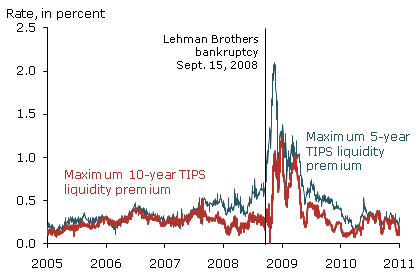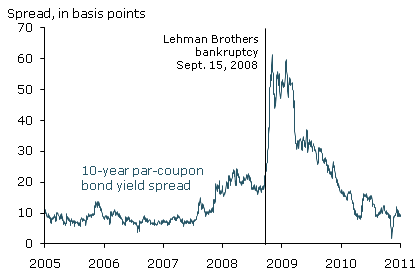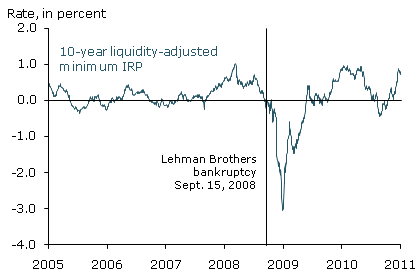While the market for Treasury inflation-protected securities (TIPS) has developed considerably over the past decade, the debate over whether their issuance benefits the U.S. Treasury remains contentious. Information from inflation swap rates in conjunction with a joint model of yields for nominal non-inflation-protected Treasury bonds and TIPS provides evidence that, even under conservative assumptions, the TIPS inflation risk premium has been large enough in recent years to offset the liquidity disadvantage of the series. This suggests that overall the Treasury has benefited from issuing TIPS.
Inflation-indexed debt securities provide bond investors with protection from inflation. They are distinct from regular debt securities in that the principal is adjusted according to changes in a given price index, thereby maintaining the purchasing power of the principal. They also include coupon payments, which reflect the compensation lenders require in addition to preservation of the purchasing power of the principal. From the standpoint of the issuer, if inflation remains positive, the primary motivation for offering inflation-indexed debt is that investors are willing to pay a premium for the protection from inflation these securities provide.
Despite this apparent advantage, issuance of inflation-indexed bonds was a contentious subject long before the U.S. Treasury inaugurated its Treasury inflation-protected securities (TIPS) program in 1997. The TIPS debate centers on the inability of inflation-protected securities to match the trading liquidity of nominal non-inflation-protected Treasury bonds. To offset the liquidity differential, investors demand higher returns on TIPS or, in other words, pay lower prices for them than they would for nominal non-inflation-protected Treasury securities of comparable duration. This liquidity discount can offset the advantage derived from the inflation risk premium and make issuance of the series costly to the Treasury.
The debate over TIPS has subsided in recent years. But, in a recent paper, Fleckenstein, Longstaff, and Lustig (2010) bring the case for these securities back into question by attempting to document systematic arbitrage opportunities in the market for TIPS that result in notably higher funding costs to the Treasury. They find that the Treasury could have saved tens of billions of dollars if it had financed all its debt using more common and highly liquid non-inflation-protected bonds rather than TIPS. Dudley, Roush, and Steinberg Ezer (2009) argue to the contrary, suggesting that issuance of TIPS benefits the public and policymakers by providing information on inflation expectations and diversifying the Treasury’s portfolio. However, neither paper attempts to quantify the advantageous inflation risk premium or the disadvantageous TIPS liquidity discount.
In this Economic Letter, we build on recent research described in Christensen and Gillan (2011) to provide a conservative estimate of the inflation risk premium. To do that, we deduct the maximum possible TIPS liquidity discount. We make a further correction to adjust for the special liquidity advantage of newly issued nominal Treasury securities. We thereby generate an adjusted measure of the inflation risk premium. This measure has been positive on average since 2005 and represents an overall net gain for the Treasury.
TIPS liquidity premiums and inflation swap rates
The difference in yields between TIPS and nominal, or non-indexed, Treasury bonds of the same maturity is referred to as breakeven inflation because it is the level of inflation at which investments in indexed and non-indexed bonds would be equally profitable. In addition to the expected inflation component, breakeven inflation is governed by two countervailing factors: the premium bond investors are willing to pay for protection against inflation overshooting its expected path and the discount they require for holding relatively less liquid TIPS in their portfolios. The former pulls TIPS yields down relative to nominal bonds, causing breakeven inflation to rise, reflecting the value investors find in the protection against inflation uncertainty. The liquidity discount pushes yields up, bringing breakeven inflation down, reflecting the compensation investors require for holding securities that may be difficult to sell. Both the inflation protection premium and the liquidity discount can vary over time, making it difficult to separate out the two effects for a given inflation outlook using observed nominal and inflation-protected yields.
The insight provided in Christensen and Gillan (2011) is to use additional information from the rates of inflation swaps to get a measure of the potential size of the TIPS liquidity discount. That, in turn, makes it possible to estimate a range for the size of the inflation risk premium. In an inflation swap, one investor agrees to pay a fixed rate in exchange for a floating payment. The floating payment equals the realized change in the consumer price index, the same index used for the inflation indexation of TIPS, over a specified period. Hence, the fixed rate, which is the quoted inflation swap rate, reflects the expected inflation rate and its associated inflation risk premium over the same period. As with the breakeven inflation rate, the swap rate will also reflect other factors, including a liquidity effect. To the extent that inflation swaps are less liquid than nominal Treasury securities, the quoted swap rate will be higher. Thus, both the inflation risk premium and the liquidity effect will raise the level of the swap rate.
Figure 1
Maximum TIPS liquidity premiums

In a frictionless world with zero transactions cost and no arbitrage opportunities, the inflation swap rate must equal breakeven inflation because both would only reflect expected inflation plus an inflation risk premium. Any difference between the two rates would be immediately pushed to zero because of costless trading in the two markets. In reality, the lack of liquidity relative to the market for nominal Treasury bonds creates wider bid/ask spreads and impedes the trading of both TIPS and inflation swaps. Consequently, the difference between inflation swap rates and breakeven inflation rates is not zero, but rather a measure of how far these markets are from the ideal frictionless state. Figure 1 shows this difference between the inflation swap rate and breakeven inflation for five- and ten-year maturities beginning in 2005.
In Christensen and Gillan (2011), we show that the difference between the inflation swap rate and breakeven inflation represents the sum of liquidity premiums on TIPS yields and inflation swap rates under certain reasonable simplifying assumptions. We refer to a liquidity premium here rather than a liquidity discount because we are looking at TIPS from the standpoint of investors. For them, TIPS yields are higher than they would otherwise be due to their liquidity disadvantage relative to nominal Treasury securities. It is implausible that either the TIPS or inflation swap rate liquidity premiums would ever be negative. Therefore, it follows that the sum of the two provides an effective upper bound to the liquidity premium in TIPS.
While we do not know the exact level of the liquidity premium within this range, we can be confident that it lies below the upper bound. With this upper bound on the liquidity premium for TIPS in hand, we can construct our conservative measure of the net benefit to the Treasury of issuing TIPS. To do so, we need a model that decomposes breakeven inflation into two components: expected inflation and the risk that inflation may overshoot its expected path, the inflation risk premium.
A joint model of nominal and real yields
We use the term structure model of indexed and non-indexed Treasury yields developed in Christensen, Lopez, and Rudebusch (2010) to decompose breakeven inflation rates (see Christensen 2008 for a short description). The data we use are nominal Treasury yields observed daily over the period from January 3, 1995, to December 31, 2010, with maturities ranging from three months to ten years. We use TIPS yields beginning in 2005 because that is when the inflation swap data becomes available. Thus, the sample includes daily TIPS yields from January 4, 2005, to December 31, 2010, with maturities ranging from five to ten years.
Figure 2
Range of ten-year inflation risk premiums

We estimate the model at both extremes of the range for the TIPS liquidity premium shown in Figure 1. First, we assume that the TIPS liquidity premium is zero and estimate the model using the TIPS yields as observed. Then we assume that TIPS yields contain the maximum admissible TIPS liquidity premium and subtract the maximum from the observed TIPS yields prior to model estimation. These two estimates produce the range of potential variation in the estimated inflation risk premiums shown in Figure 2.
To produce our measure of the benefit of TIPS, we take the smallest admissible inflation risk premium in Figure 2 for each observation date and deduct the maximally admissible TIPS liquidity premium at the ten-year horizon shown in Figure 1. We also deduct the yield spread between the seasoned Treasury yields we use in the model estimation and newly issued Treasuries, shown in Figure 3, to correct for the fact that nominal bonds are issued at very low, so-called on-the-run yields due to their high liquidity. We refer to the resulting measure as the minimum liquidity-adjusted inflation risk premium, which is shown in Figure 4.
Figure 3
Ten-year off-the-run over on-the-run Treasury yield spread

While this liquidity-adjusted measure of the smallest possible inflation risk premium is the most conservative estimate we can generate using the Christensen, Lopez, and Rudebusch model, it is still positive for 63.9% of the sample at the ten-year maturity. The figure shows that during the height of the financial crisis, when the market demand for liquidity and safety was extremely high, issuing TIPS was notably more expensive than funding with nominal Treasury bonds. However, even with that crisis period included, the mean value of the adjusted inflation risk premium was 7.1 basis points (0.071 percentage point), while the maximum was 103.1 basis points (1.031 percentage points). Furthermore, in Christensen and Gillan (2011), we provide evidence suggesting that the TIPS liquidity premium is likely to be in the lower half of the admissible range, far below the value assumed in the calculation above. This is a strong indication that the Treasury has benefited from issuing TIPS throughout most of the six-year sample we consider.
Conclusion
Figure 4
Ten-year minimum liquidity-adjusted inflation risk premium

While the market for TIPS has developed considerably over the past decade, the debate over whether their issuance ultimately benefits the Treasury remains contentious. Information from nominal and real Treasury yields can be combined with information from inflation swaps to produce an upper bound to the TIPS liquidity discount. This allows us to estimate inflation risk premiums while accounting for a maximal TIPS yield liquidity correction. Including a further correction for the liquidity differential between on-the-run nominal yields and off-the-run yields used in model estimation provides a conservative measure of the net benefit to the Treasury of issuing inflation-indexed debt. The positive average value of this liquidity-adjusted measure of the inflation risk premium for intermediate- and longer-term TIPS over the past six years supports the continued issuance of TIPS by the Treasury.
Reference
Christensen, Jens H. E. 2008. “Treasury Bond Yields and Long-Run Inflation Expectations.” FRBSF Economic Letter 2008-25 (August 15).
Christensen, Jens H. E., and James Gillan. 2011. “A Model-Independent Maximum Range for the Liquidity Correction of TIPS Yields.” Unpublished manuscript, FRBSF.
Christensen, Jens H. E., Jose A. Lopez, and Glenn D. Rudebusch. 2010. “Inflation Expectations and Risk Premiums in an Arbitrage-Free Model of Nominal and Real Bond Yields.” Journal of Money, Credit and Banking 42(6, Supplement), pp. 143–178.
Dudley, William C., Jennifer Roush, and Michelle Steinberg Ezer. 2009. “The Case for TIPS: An Examination of the Costs and Benefits.” FRB New York Economic Policy Review 15(1, July), pp. 1–17.
Fleckenstein, Mathias, Francis A. Longstaff, and Hanno Lustig. 2010. “Why Does the Treasury Issue TIPS? The TIPS-Treasury Bond Puzzle.” NBER Working Paper 16358.
Opinions expressed in FRBSF Economic Letter do not necessarily reflect the views of the management of the Federal Reserve Bank of San Francisco or of the Board of Governors of the Federal Reserve System. This publication is edited by Anita Todd and Karen Barnes. Permission to reprint portions of articles or whole articles must be obtained in writing. Please send editorial comments and requests for reprint permission to research.library@sf.frb.org